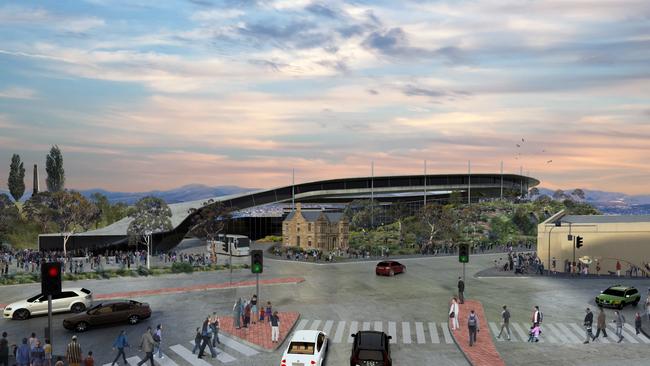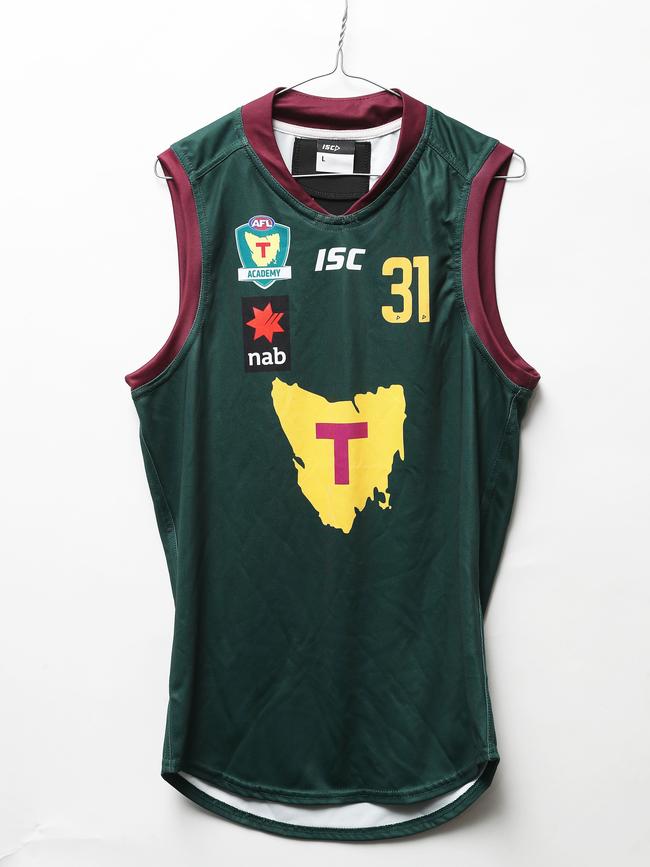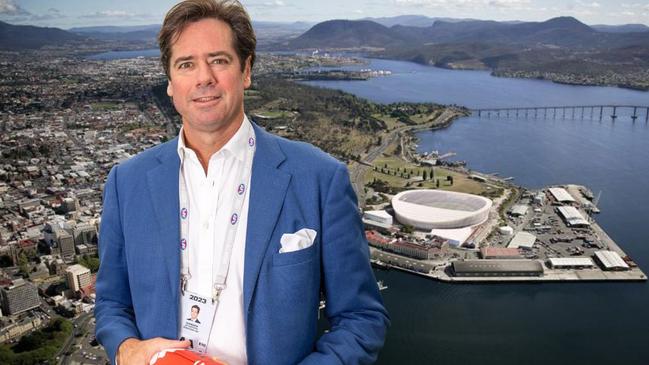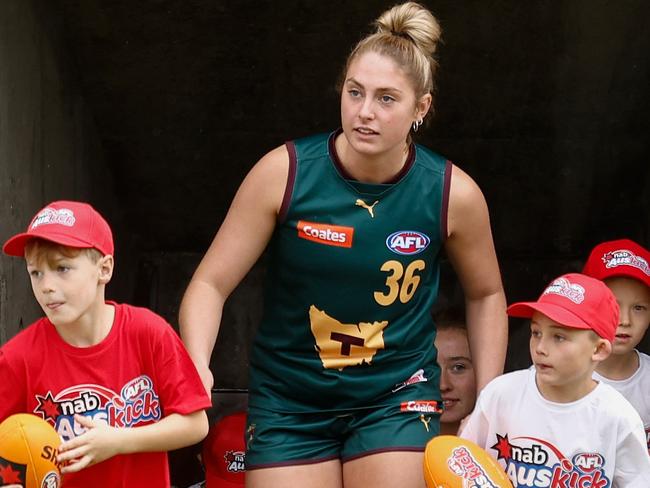Everything you need to know about footy in Tasmania: The club, the costs and where to next
It’s official. Tasmania is part of the AFL. What needs to happen before the club’s 2028 debut? We look at every big question here.

AFL
Don't miss out on the headlines from AFL. Followed categories will be added to My News.
It’s Tassie time. After seven previous failed bids, Tasmania will enter the AFL in 2028.
As the author of the review of the licence bid Colin Carter put it on Tuesday, “a hole in football’s soul has been filled”.
So how does it actually look? Here’s your ultimate guide to Tasmanian football — and where to from here.
THE TEAM
Tasmania will enter the competition in 2028, becoming the AFL’s 19th club after decades of campaigning from the proud football state.
The club will have a team in the VFL by as soon as 2025 and will start recruiting players ahead of that season. Premier Jeremy Rockliff said a VFLW outfit would also be established.
A start date for the club’s AFL Women’s outfit is set to be confirmed soon.
THE NAME
Overwhelming local support is for the team to be named the Tasmania Devils in honour of the state’s most famous living marsupial.
But fans will get their say on name, logo, guernsey and club song.
A potential stoush looms with entertainment behemoth Warner Bros which is territorial about its famed Looney Tunes character, Tasmanian Devil.
There’s the Mariners, the Islanders. But as Herald Sun chief football writer Mark Robinson said on Tuesday, surely goodwill prevails and the Bros will give way. Stay (Looney) tuned.
A public vote could ultimately decide the name, as happened with Tassie’s NBL side the JackJumpers.
One thing’s for sure, the Tasmania Tigers is extinct.

THE COLOURS
There is strong support to use the map of Tasmania on its jumper, as a symbol to unite the state.
A green, maroon and yellow jumper featuring the map of Tasmania has been used in the push to secure the team, with those colours remaining the frontrunner for team branding.
The Tasmania Devils Coates League team currently plays in the green, maroon and yellow jumper proudly bearing the map.
THE STARS
The new club is likely to get $1 million outside the salary cap to provide sign-on bonuses for big-name players, and will benefit from a special Tassie father-son clause.
Free agency concessions, longer contracts for young players and first dibs on local star juniors are also in the mix.
It’s unclear if there will be ongoing salary cap concessions as an aid to player retention, with the go-home factor likely to be a serious issue for the 19th club just as it has been for the 17th and 18th teams – Gold Coast and GWS.
Attracting a big name will be crucial, and clubs will be nervous about what access Tasmania gets to their stars and what draft free kicks the new team will be awarded.
It’s likely Tasmania will be given a raft of valuable draft picks to trade for players with 70-120 games under their belts, to help the new team to be competitive from the outset.
Experienced recruiter Matt Rendell said this week clubs should expect at least three years of pain.
There will be caps on how many players could be lost from one team to Tasmania.
But Gillon McLachlan said while there’ll be concessions, they can’t muck around.
“I think there’s an acknowledgment now that the patience is less in our competition and the team will have to compete more aggressively … from year one,” he said.
But he is adamant that drafts will be “much less compromised than before” and there will be “much less impact on the competition” than previous expansions.
THE COACH
Being the inaugural coach is a mighty honour, but with it comes pressure to perform.
Alastair Clarkson has also been a vocal supporter of Tasmania’s addition to the competition, with his deal at North Melbourne set to end at the end of 2027. One to watch.
Local products in the coaching sphere include Chris Fagan, while Brendon Bolton is also a member of the state’s hall of fame and could eye a return to the senior coaching ranks.
Rising assistant coaches in the AFL at the moment include Corey Enright, Jaymie Graham and Adem Yze – could there be a succession plan in place like GWS did with Kevin Sheedy and Leon Cameron? Justin Leppitsch and Don Pyke are more experienced former coaches that could be lured south.


THE HOME GROUND
Hobart gets a brand new 23,000-seat stadium with a roof at Macquarie Point at a forecast cost of $715 million, slated to open in 2028.
Initial costs of $750 million were revised down after tense negotiations between the AFL and the Tasmanian and Commonwealth governments, and Prime Minister Anthony Albanese sealed the deal last Saturday when he pledged $240 million from Canberra.
The Tasmanian Government tips in $375 million, $15 million will come from the AFL and a further $85 million is pegged from borrowings against land sales and leases.
Tasmanian premier Jeremy Rockliff will be praying for a project delivered on time and on budget because Albanese said the Commonwealth wouldn’t be paying for any overruns: “I have confidence the Tasmanian Government will be able to get this project right.”
THE ROOF
The AFL is determined to have a roof at Macquarie Point. The flexibility that a roof would allow in what has become the modern stadium experience is considered a priority, particularly in the “crisp” – and on some days that’s putting it kindly – Hobart climate.
In announcing the new team licence, Gillon McLachlan made a point of referencing the “roofed” stadium that would be constructed.
Cricket doesn’t want a roof because you can’t play Test cricket under one.
But then again, cricket isn’t paying.
THE COST
The AFL has confirmed a $360 million package for football in the state that will include $209 million in funding of the team and more than $100 million for junior development and grassroots football in the state.
The Tasmanian Task Force estimates that “the club will be profitable if it receives an AFL distribution of $17 million per year” – which would have it sit in the “middle of the bottom third” of clubs – and that the Tasmanian government would also need to plough in between $7 million and $11 million per year.
The state government will also contribute $12 million per year over 12 years towards a team, along with another $60 million for a high-performance centre.
Carter noted that no existing club would be worse off due to increased media revenues generated by 11 extra games a year.

THE BACKERS
Key Tasmanian brands – think Cadbury, Hazell Bros, Spirit of Tasmania, Cascade and Boag’s – will be champing at the bit to get a look-in with the hottest new team in town, but national brands will also see the potential huge upside of getting on the bandwagon early.
It’s a prime market locally, and fans will be flocking from around the country. Add guaranteed TV exposure and who wouldn’t want a piece of that?
THE FIRST GAME
Round 1, 2028 is the big day – but against who? Hawthorn or North Melbourne have claims given their recent tenancies in the Apple Isle. They have strong historical links too – think Peter Hudson and Brent Crosswell.
Maybe Richmond, with Tassie’s favourite son Matthew Richardson a popular link between the old and new. Could work.
Maybe the league will look to hook into the former club of a new marquee star. Makes marketing sense.
“Famous icons and wonderful ambassadors and true legends of the great game,” premier Jeremy Rockliff described some of the big names of Tasmanian footy.
Reckon St Kilda is the early favourite though. The Saints have arguably the greatest links to the state, and none bigger than the Doc. The Darrel Baldock Cup has a nice ring to it.
THE SEASON
It is expected that the new team will split its home games between Hobart and Launceston.
If it enters the competition before the Macquarie Point stadium is complete, this split could more heavily favour Launceston’s UTAS Stadium before being more weighted to Hobart in the following years. Bellerive Oval also remains a live option in the early years.
Eventually, it is anticipated that the team would play seven home games at Macquarie Point and four games at UTAS Stadium, which received a $65 million federal funding boost for upgrades during Albanese’s visit last weekend.
Penguin’s Dial Park has been earmarked to host pre-season games.
THE FLY-INS
Hawthorn is tied to Tasmania until at least the end of 2025, playing four home games in Launceston.
North Melbourne is locked away in Hobart for the same period and number of games.
Will Tasmania be willing to stump up millions for the Hawks and Roos in 2026 and 2027, as the local team prepares for takeoff? Time will tell.
But surely the Tasmanian Government couldn’t afford to fly in an AFL team from 2028 when it is helping to pay costs for the state’s new permanent team?
Looking long term, the Carter report indicated a belief that even if the North and Hawthorn deals with Tasmania were to end, shifting the games back to Victoria would mean they would be no worse off financially in the long term.
Hawthorn has committed to hosting its home game against a Tasmanian team at UTAS Stadium.
Tasmania could enter the VFL competition as a prelude to its introduction to the AFL, and split its games between Bellerive Oval in Hobart and UTAS Stadium in the north.

THE FANS
While the state united behind “the map” jumpers in years gone by of state representative football, a lack of a Tasmanian team has meant – as Carter noted in his review – many Tasmanians are “rusted on” to their AFL team.
It remains unknown how many will shift teams or purchase a second membership. It has been estimated that around 38,000 members can be expected for the new team, at a yield of $128 per member. That’s just shy of $5 million a year.
Memberships could be tailored to accommodate for the split in games between Launceston and Hobart in a bid to be accessible to as many Tasmanians as possible.
While the north-south rivalry is real, Carter noted, teams like the Hobart Hurricanes and Tasmania JackJumpers have received statewide support.
THE BACK-ROOM PLAYERS
Like all new outfits, who is steering the ship off the field is equally – if not more – important than who is running out in the team jumper. Especially early.
The AFL and state government will get a say in who they are.
The chief executive will be followed by football department staff – crucially in the area of recruiting.
Current Richmond boss Brendon Gale is a proud Tasmanian and, while earmarked for a potential role at league headquarters to take the lead on the league’s newest venture, could loom as a likely target once the club is up and running. The Herald Sun reported on Saturday AFL game development executive Sam Graham — a spearhead at HQ for the project — was tipped to be the interim CEO.
Former Tasmanian premier Peter Gutwein could be the perfect first club chairman for the state’s flagship new team and has indicated his interest.
Businessman Brett Godfrey, who chaired the Tasmania Task Force, will also be considered, as will Tassie locals who went on to play at the highest level like Matthew Richardson and, in years to come, Jack Riewoldt, in either a football or administrative role.
The initial board will be five people, grown to seven by its 2028 start.
The team is expected to target one of the game’s most shrewd list-builders, with names like Kinnear Beatson (Sydney) and Stephen Wells (Geelong) already floated.
THE FIXTURE
What does adding a 19th team mean for the finals? Adding Gold Coast and Greater Western Sydney to make 18 teams hasn’t seen any change to the top-eight system, but 19 or 20?
The league is yet to confirm plans or float ideas for what the finals set up could look like.
But as one club official this week suggested, it could present an opportunity to trial a top 10, or even a top six with a playoff for the final two spots in the bye weekend, keeping more teams alive for longer.
The bye is another element the league’s fixturing boffins have to face. It’s not new ground given the AFL had the same issue when the Suns joined in 2011. Then, one team had a bye each week, rather than the clumps of bye weekends that are now spread across the middle of the season.
This would likely be the case in the short-term, but league legend Leigh Matthews expressed his doubt this week that the game would stay at 19 teams for long.

THE TRAINING BASE
Expect the team to be based in or around Hobart, where the league will be putting $10 million towards a high performance facility likely not far from the Macquarie Point showpiece stadium. It could have offices in the city within months, with work to begin immediately on where the training and administration base will be.
THE AFLW
The licence also covers entry into the AFL Women’s competition.
When that is remains to be seen, with the league saying on Tuesday that confirmation regarding the AFLW outfit would come “shortly”.
Kangaroo and Tasmanian Nicole Bresnehan was at North Hobart for the announcement.
“Tasmania’s best have had to cross Bass Strait in order to show the country what they can do. All of that changes today,” deputy Prime Minister Richard Marles said.
GATHER ROUND 2028?
A trip over on the Spirit of Tasmania, a short flight from Adelaide or Melbourne, Salamanca Market, a boat trip to MONA, brunch a stone’s throw away in Kingston Beach and walk to the footy in the afternoon. The advertisement for a Gather Round on the Apple Isle in the April school holidays just about writes itself.
“It’s been discussed,” McLachlan said.
“I think it’s clear we want to get to Sydney and to Perth. But it’s a beautiful place to have something like that. The intimacy here (at North Hobart) … it’s a good idea. There’s other priorities and we’ll work through that.”
THE 20th CLUB
An odd number of teams in the fixture just doesn’t fit. And while the ink isn’t even dry on the Tasmanian licence, conversation has already turned to where the league’s 20th team could be situated.
Western Australia, Northern Territory and Canberra have all been floated.
Newcastle or northern New South Wales is another option but amid questions of the state of Australian rules in the state, that seems unlikely.
Colin Carter said on Tuesday he doesn’t see a “natural” home for a 20th club.
Incoming league chief executive Andrew Dillon is playing his cards close to his chest.
“We’ve had an odd number of teams in the competition a number of times,” he said this week.
“We’ve had 15 teams, 17 teams for a year when Gold Coast came in. It’s something you may look at but that’s something a long way down the track. We’re not even at 19 yet.”
Originally published as Everything you need to know about footy in Tasmania: The club, the costs and where to next





